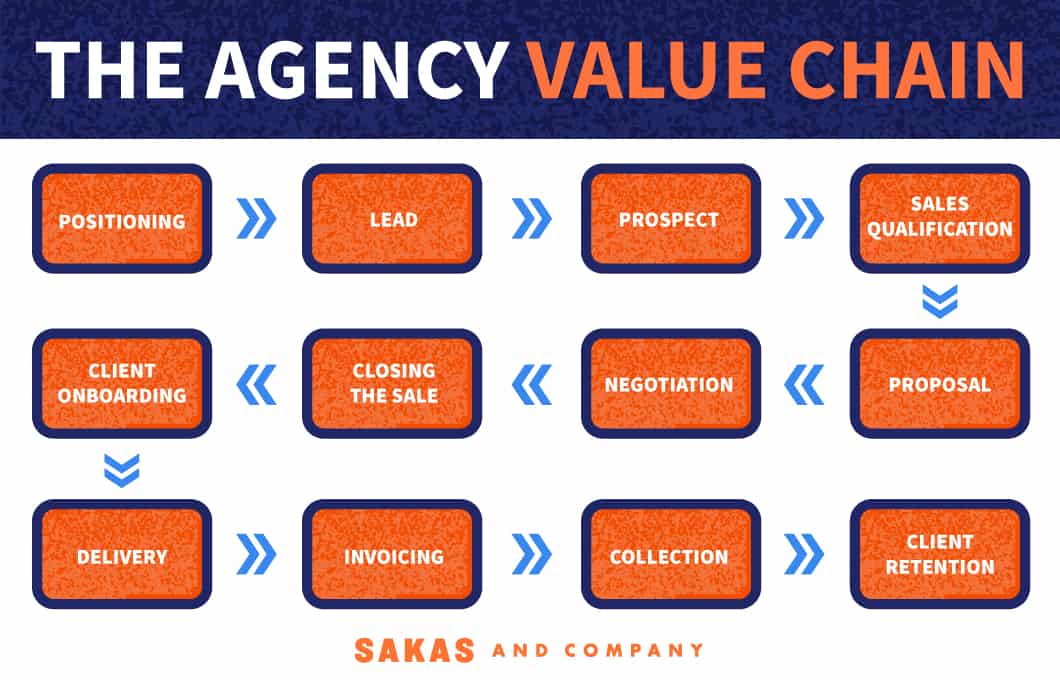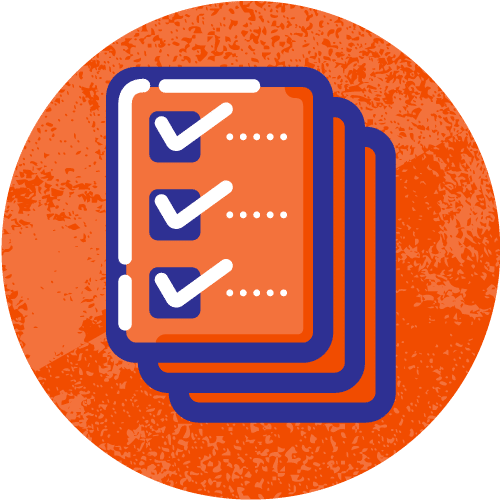
Find ‘profit leaks’ via my Agency Value Chain framework. (click for larger version)
If your net profit margins are below 20%, your agency is “leaking” profits. Use my Agency Value Chain framework to find those profit leaks so you can fix them.
As you can see in the diagram, the value chain has 12 steps:
1. Positioning –> 2. Lead –> 3. Prospect –> 4. Sales Qualification –> 5. Proposal –> 6. Negotiation –> 7. Closing the Sale –> 8. Client Onboarding –> 9. Delivery –> 10. Invoicing –> 11. Collections –> 12. Client Retention
In my experience, there are common “profit leaks” at each point in the Agency Value Chain—and I describe them below. You’ll still need to fix the leaks, of course—but now you’ll know where to focus.
Using the Agency Value Chain to find “profit leaks”
Thinking about your agency, let’s walk through the 12 steps. Take notes as we go—there’s typically more than one leak.
1. Positioning
Are you clear on your agency’s ideal client(s)? Is your team clear on your positioning and your vision, too? And do all of your marketing activities support conveying the right positioning?
Specialist agencies tend to charge higher prices than generalist agencies. If you’re a generalist, how long can you afford that gap in profits?
2. Lead
Once you sort out your positioning, how’s your own self-marketing? For agencies, marketing exists primarily to support your lead-gen efforts. That is, marketing exists to supports sales.
Are you consistent about your self-marketing? Are you using your agency’s own services to market yourself, to show clients what they’ll get?
I recommend a three-step agency marketing strategy I call “Inbound Branding“: 1) specialize, 2) share thought leadership marketing, and 3) use marketing automation to stay top-of-mind.
The stronger your sales pipeline, the less likely you’re going to panic under a “feast or famine” cycle. “Panic” and “profits” rarely go together at an agency.
3. Prospect
Are you—and your team—clear on who’s a qualified sales prospect? Use my CRUX sales qualification method to more-effectively screen your prospects. To summarize, CRUX looks at:
- Compatible: Do they need your help? Are they someone you want to serve?
- Realistic: Do their expectations, goals, and budget match? Is the contact a decisionmaker? Do their metrics make sense?
- Urgent: Is the timing right for you and them? Once you start, will they stay engaged?
- X-Factor: What’s your “gut feeling” on the prospect? Are you excited to spend the next several months—or years—with them?
Are you sharing free tips on a regular basis, via your email newsletter and other channels? If not, you’re missing opportunities to stay top-of-mind as a high-value agency, to ‘automagically’ convert someone from “lead” to “prospect.”
Does your website make it easy to get in touch? Or do people have to “hunt” for it? Do you offer phone, email, and webform options? What about a chatbot or other chat box?
Whichever methods you use, do you set expectations for what happens next? For instance, your webform should indicate how fast the prospect should expect to hear back. You don’t want otherwise qualified prospects leaving because they assumed incorrectly.
4. Sales Qualification
Create—and use—a “fast fail” sales process. If you’ll get on the phone with anyone who requests a call, you’re wasting time… and at an agency, that’s wasting money.
Once you gather the initial info, be helpfully skeptical (or perhaps “skeptically helpful”). After all, not everyone’s a match for you, and vice versa. Be picky.
With rare exceptions, don’t do an exploratory (sales) call with an inbound prospect without their first completing your sales pre-qualification survey. Remember, time is money.
For a deeper dive, read my in-depth article on agency sales process.
5. Proposal
Be sure you understand what the prospect actually needs, since it’s not always what they think they want. (But keep in mind that they make decisions based on the “want” side of the equation.)
You might save time by using sales proposal software—but don’t let the software’s convenience lead you to stuff the proposal with things the client doesn’t care about.
Be sure you convey that you understand the prospect’s unique Values, Goals, and Resources (VGR). If you do generic proposals every time, you’re missing a key opportunity to add value.
Don’t get hung up on features. Instead, use my “Which means…” framework to explain things in a way that connects to your prospect’s needs and wants.
In one of my few absolutes, never create a proposal for a prospect who doesn’t have a budget. (Give them a broad price range instead, and they can come back when—and if—they have an actual budget.)
Are you learning from past estimates? Otherwise, you’re leaving money on the table—and I can guarantee you have profit leakage if you don’t do debriefs after your projects and retainers.
Look at how you invest time in sales proposals. You may be able to finish proposals faster—and the “fast failure” portion includes your creating fewer proposals in the first place.
Finally, deliver proposals “live” or in a pre-scheduled review meeting, to reduce the chances that prospects “ghost” you by disappearing into The Abyss. Never just email them a PDF.
6. Negotiation
Study and practice to build your negotiating skills—this isn’t time to “wing it.” You might like Never Split the Difference by FBI hostage negotiator Chris Voss. I also like Robert Ringer’s three-part audio series on dealmaking (regardless of whether you agree with his politics or specific examples).
Look for a prospect’s decisionmaking “tells” and adjust accordingly.
Take time to understand each decisionmaker’s incentives. Success frequently comes down to incentive alignment—but it’s up to you (and your salesperson) to demonstrate how your solution aligns with their incentives.
Don’t cut your price without also reducing the scope. This is a big profit leak at many agencies—and they lose five or six figures in just a couple sentences. If it seems like you might need to make a concession, never agree on the spot—instead say: “Let me consider that. I’ll regroup with my team and follow up with you.”
If you need to drop a major feature because the prospect won’t pay for it, call it out it in the final SOW in a list of specific exclusions. This reduces the chances later that the now-client claims something should be free because they “didn’t know.” They’ll know—because they signed or initialed that specific page in the contract.
7. Closing the Sale
Do you have a standard client agreement that protects you against common problems? For instance, you want the right to stop working if the client becomes past-due.
You also want to retain ownership until the client pays in full. Be sure to cover re-using components for other clients. I’m not a lawyer, but commonly I’ll see language that shows the agency owns the work (but the client has a license to use it) or vice versa.
Get your attorney’s advice to close loopholes. My clients typically work with lawyers who specialize in agencies, like Matchstick Legal or Sharon Toerek, if their day-to-day attorney doesn’t have sufficient agency expertise.
Create a policy—don’t even schedule the kickoff meeting until they’ve signed the contract and paid the deposit. This seems small, but it can have a huge impact—I learned it the hard way as Director of Client Services at an agency. Once you schedule the meeting, the train’s moving. If the prospect says “But I’m in a hurry,” nothing proves that like their paying you money.
8. Client Onboarding
Speaking of kickoff, kickoff meetings are vitally important—are you successfully handling the most important meeting of each client’s relationship with your agency? This includes managing expectations, nailing down core details, and otherwise starting on the right foot.
Are you gathering key details about what the client expects? Doing a pre-kickoff survey helps you understand what each stakeholder has in mind—and can even help you find up-sell opportunities before starting the rest.
Do you require that every key decisionmaker participates in kickoff? (If not, expect profit-damaging “swoop & poop” from client execs later in the engagement.)
Delayed projects tend to cost more money—and rob you of an opportunity to sell the timeslot to another client. Are you asking how much time each stakeholder plans to spend on their portion of the work? And are you getting a list of everyone’s upcoming PTO? Your account manager and project manager should know those details, to help them manage accordingly.
To save time as you create or upgrade your client onboarding, get my Agency Profitability Toolkit—the 60+ resources include my 20-page eBook on client onboarding, my kickoff meeting agenda template, and 12 more tools, SOPs, and templates to make account management more profitable.
9. Delivery
Delivery is the broadest item in the Agency Value Chain. It includes four of the six Agency Roles (AM, PM, SME, and client strategy).
At its core, Delivery is about successfully balancing both Warmth and Competence. That is, you complete the work competently (ideally on-time, on-scope, and on-budget) and clients have a good experience and want to keep working with you.
These two factors aren’t inherently opposites, but they definitely tend to compete with each other:
- If you’re all Competence and no Warmth, work may be profitable, but Client Retention (step 12 in the Value Chain) will be terrible.
- If you’re all Warmth and no Competence, Client Retention may be relatively strong… but they’re just renewing unprofitable work.
Look at your team’s direct incentives. Are you promoting Warmth, Competence, or both?
Look at your team’s indirect incentives. What do you and other managers say to people? Is it all about getting things done on time, or about client happiness? Or are you inconsistent? The more the team knows your Values, Goals, and Resources (VGR), the more they can make good decisions without asking you every time.
Stepping back, consider the three levers for delivery profitability: price, scope, and scope management. Your highest profit margins depend on all three working well.
If you say you’re a boutique agency, are you truly creating a boutique client experience? A boutique approach can help you charge more, but it requires successful delivery on both Warmth and Competence.
Do your PMs think about profitability when they staff projects and retainers? If they don’t know your budget and cost assumptions, you’re making it hard for them to do their job… which erodes your profits.
Are you reflecting on what did and didn’t work? Is your operations team doing a work breakout (WBO) and other post-engagement debriefs after completing projects and retainers? You otherwise can’t learn from past mistakes—and past successes—and that’s hurting your profit margins.
Do you document—and use—internal Standard Operating Procedures (SOPs), or do people “make it up” every time? Adjusting and adapting over time is good, but making it up every time is bad when it involves your primary services. You want to balance best practices with individual creativity, but “no SOPs” means your team has to muddle along… and each client will tend to have a wildly different experience with your agency.
Do you have an agency-level traffic manager making decisions about resource conflicts? Their title may vary—VP of Operations, Production Manager, or perhaps one of your senior Project Managers. But someone needs to be making the final call when two different teams need the same resource(s) at the same time. Otherwise, the subject matter expert (SME) will be overloaded, and one or both clients will be unhappy with your progress. This doesn’t lead to sustainable profits.
Are you regularly sourcing new team members who can complete work accurately and profitably? Proactive recruiting helps you find future hires before it becomes an emergency. Once something becomes an emergency, you prioritize speed over profits. This tends to hurt profits, and the time pressure tends to hurt quality… which means you often have to re-do the work. Congrats, you just paid extra to do work poorly… and the client’s unhappy.
Do you negotiate scope changes… or automatically say “yes” to anything a client requests? I recommend using my “Reason-Options-Choose” conversation framework to create more profitable outcomes.
Do your account managers have a framework for pushing back against scope creep? I have seven magic words to help you stop scope creep.
Do you call-out freebies? “Strategically free” is good; “secretly free” is bad.
There are plenty of additional potential profit leaks within Delivery—but these should get you started.
10. Invoicing
Are you sending invoices promptly? If you wait months to invoice the work, you create all sorts of problems. Clients may not remember the positive impact of your work, you may forget to invoice all the work, and—regardless—you paid your employees and contractors a long time before you get paid back.
Think twice about re-billing clients for things like media buys and printing. Yes, you can get your ~15% markup, but this only works if you can afford to “float” the cash between outflow and inflow. It’s even less compelling if you have to borrow money yourself to make this work. Unless you’ve structured your agency to handle re-billing profitably, I recommend having clients pay media and printing bills directly, with your agency charging a separate management fee.
If someone is on a fixed-amount monthly retainer, they should be paying before the month starts, not after. I require most payments in advance, or else Net 7.
Run the numbers—you should consider accepting credit cards. This negatively impacts profit margins, but I believe it’s an important “cost of doing business” for most agencies. See my article on the topic to decide for yourself.
11. Collections
This is the simplest profit leak to address—but if you’re disorganized or non-confrontational, it’ll be a hard one to fix.
Do you have—and use—a process to escalate your reminders? Otherwise, things will slip through the cracks. This includes asking clients to confirm receipt on invoices, pinging before the due date, and immediately reaching out as soon as a client is past-due. You’ll also want to understand each client’s Accounts Payables process, so you know where to press as the “squeaky wheel.”
As I mentioned earlier, be sure your client agreement gives you the option to pause future work if the client becomes past-due. Otherwise, you have nearly zero leverage.
Are clients on auto-bill yet? Never wonder if you’ll get paid—because you’ll automatically get paid via the client’s auto-pay authorization. There’s still some administrative management, but it can make a huge difference on getting paid promptly and fully.
If clients tend to withhold or otherwise delay payment because they want revisions to a deliverable, build revisions into your SOW milestones. That is, payment is due on delivery—and then the next milestone includes your revisions to the prior deliverable.
If you struggle on accounts receivable, I have a whole series of articles on collections at agencies.
12. Client Retention
Once you get a client… do you keep them? If collections is the simplest profit leak to fix, client retention is perhaps the highest-leverage place to fix profit leaks.
After all, you’ve done all this work to land the client—any cross-sells and upsells will be easier revenue than any new business development. But if you instead lose clients who’d otherwise stay, everything before this stage becomes harder.
If you work primarily on retainer, you should be retaining 80-90% of your clients each year. (If you’re project-based, churn will be higher… but you’d likely have a strong sales pipeline already.)
If you aren’t seeing those numbers, you’re likely leaking profits on client retention. Consider:
- Are you and the entire team committed to Warmth & Competence?
- Are you doing ongoing client satisfaction surveys—and acting on what you learn?
- Are you eliminating stupid policies and practices?
- Are you making clients the Hero of their story (good) or trying to steal the credit (bad)?
If you don’t measure retention yet, look backwards to calculate your retention stats for the past year. I recommend doing it based on both revenue and client count, to give you more-actionable insights
Next Step: Fixing the Profit Leaks… and Underlying Themes
Whew! How many profit leaks did you find at your agency?
You’re not done, unfortunately—now that you’ve found the leaks, you still need to actually fix them.
Triage the Leaks by Expected ROI
If you want to triage the profit leaks yourself, think about return vs. investment. That is, what’s the ROI on the resources (money, time, and energy) required to address each profitability problem?
Ideally, you’d first fix items that have a high potential return and a low expected investment, before you move on to the high-return, medium-investment list.
Look for Problematic Patterns
But before you jump to solutions, step back for a moment. What themes do you see across the individual profit leaks? For example:
- Inconsistent marketing? —> Leads to insufficient leads, and increasingly desperate sales choices.
- Poor team management? —> Leads to inefficient delivery, and deteriorating client retention.
- Avoidance of uncomfortable conversations? —> Leads to wasting time on poor sales prospects, closing underpriced deals, and continuing to serve past-due clients.
If you don’t address those problematic patterns, you’re likely to see new, preventable profit leaks in those areas in the future. Agency coaching can help, and so might therapy—but only once you’re willing to change.
Question: What “profit leaks” did you find using the Agency Value Chain?


